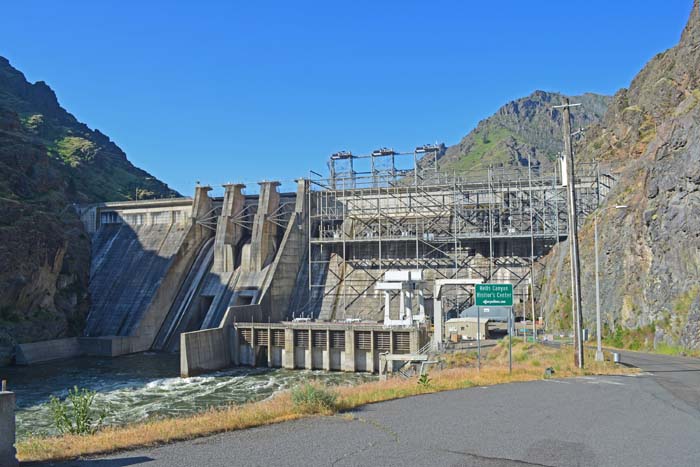Burns Paiute Tribe calls on feds to require Idaho Power to return salmon, steelhead to Snake River, tributaries above three dams in Hells Canyon
Published 10:02 am Tuesday, December 5, 2023

- Hells Canyon Dam is the highest of Idaho Power Company's three dams in Hells Canyon east of Baker City. The others are Oxbow and Brownlee.
The Burns Paiute Tribe is calling on the federal government to require Idaho Power Company to take steps to return salmon and steelhead to the Snake River and its tributaries upstream from the company’s three dams in Hells Canyon.
Idaho Power built the dams over about a decade starting with Brownlee in the late 1950s, followed by Oxbow and Brownlee dams.
None of the dams has fish ladders, and the construction of Brownlee, which is downstream from the Powder River, blocked salmon and steelhead from reaching the Powder, Burnt and Malheur rivers.
The Malheur River, which enters the Snake River near Ontario, was a main source of anadromous fish for the Burns Paiute Tribe, according to a Dec. 1 press release.
“The Tribe has a spiritual connection to all the plants, animals, and places in its territory,” the press release states. “The connection with the Agai’ or salmon is especially strong.”
In a letter to the Federal Energy Regulatory Commission (FERC) and other federal agencies, the tribe is “demanding that action be taken to restore salmon to the Tribe’s homelands,” according to the press release.
FERC issued a 50-year license to Idaho Power for the three dams in 1955. Although the license expired in 2005, the company, based in Boise, has continued to operate the dams under the initial license. Idaho Power submitted a 25,000-page application for a new 50-year license in 2003, but FERC has yet to issue that license.
“It is long past time for Idaho Power, FERC and other federal agencies to recognize the impacts that the Hells Canyon dams have had on the Burns Paiute Tribe and its people,” said Diane Teeman, chair of the tribe. “Salmon are a central part of our culture. We are salmon people. The loss of salmon in places they used since time immemorial, like the Malheur River, impacts the health, economy and culture of our people. We call on the Biden administration to recognize that these Hells Canyon dams have devastating impacts and to use FERC’s relicensing process to remedy those impacts.”
Idaho Power tried to net returning anadromous fish below Brownlee dam, which was finished in 1958, and release the fish above the dam.
But that strategy failed, in part because young fish migrating downriver couldn’t navigate the 53 miles of slack water in Brownlee Reservoir. Instead the company built a hatchery at Riggins, Idaho, to breed salmon.
In its letter to FERC, the Burns Paiute Tribe wrote that the tribe filed for intervenor status in 2003, the year Idaho Power filed its application for a new 50-year license.
The tribe contends that new technologies, employed at other dams, make it possible to restore salmon and steelhead runs above dams by methods other than fish ladders, such as transporting fish on barges.
Although anadromous fish can’t reach the Malheur River due to the dams, in May 2016 the Burns Paiute Tribe released chinook salmon in the upper Malheur River “as tribal members gathered to fish for and witness Chinook Salmon swim in the upper Malheur River for the first time in 97 years,” according to the letter to FERC.
Those fish can’t migrate to the Pacific Ocean due to the dams, but tribal members believe habitat conditions in the north and middle forks of the Malheur are suitable to support salmon and steelhead runs.
Idaho Power spokesman Sven Berg said that although the company “understands the importance of anadromous fish to the Burns-Paiute Tribes, the company does not believe our project was central to the loss of these fish in the Malheur River basin. When the Hells Canyon Complex was built, the Malheur River basin was not contributing to anadromous returns above Hells Canyon Dam. Land use practices — especially mining and agriculture — and construction of federal dams to support irrigated agriculture have been central to the loss of anadromous fish in the Malheur River.”
The tribes acknowledged the history in its letter to FERC, stating that the construction of the federal Warm Springs Dam in 1919 on the Middle Fork of the Malheur River, and of Agency Valley Dam in 1935 on the North Fork of the Malheur, blocked fish passage to multiple tributaries and significantly reduced the size of anadromous fish runs in the Malheur Basin prior to Idaho Power building its dams.
“The extirpation of anadromous fish in the Malheur Basin was completed 65 years ago with the construction of Brownlee Dam in 1958,” the letter states. “(The tribe’s) desire to restore these culturally important fish has never weakened.”
Berg said Idaho Power’s hatchery program releases nearly 7 million salmon smolts annually.
He said, however, that the company “is not a fish management agency and has no authority to distribute or release fish anywhere.”
Several years ago Idaho Power agreed, if it receives a new federal license for the three dams, to release chinook salmon and summer steelhead in Pine Creek, a Snake River tributary in eastern Baker County.
The company would study the fish to determine whether they’re able to spawn successfully.
“Idaho Power believes this evaluation should take place before further decisions are made regarding placing anadromous fish in tributaries upstream of the complex,” Berg wrote.
The tribe, in its letter to FERC, notes that Idaho Power’s program to maintain anadromous fish runs through its hatchery program benefits tribes along the lower Snake, but not areas above the company’s dams, including the Burns Paiute Tribe’s traditional lands in the Malheur Basin.




